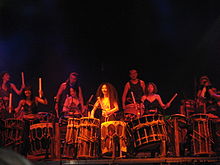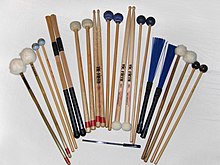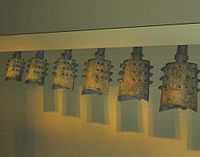Percussion instrument
This article includes a list of references, but its sources remain unclear because it has insufficient inline citations. (March 2015) (Learn how and when to remove this template message) |

Yoruba drummers: One holds omele ako and batá, the other two hold dunduns.

Orchestral percussion section with timpani, unpitched auxiliary percussion and pitched tubular bells

Djembé and balafon played by Susu people of Guinea

Concussion idiophones (claves), and struck drums (conga drum)

Modern Japanese taiko percussion ensemble

Very large drum kit played by Terry Bozzio

A percussion instrument named mridangam played by T. S. Nandakumar

Evelyn Glennie is a percussion soloist
A percussion instrument is a musical instrument that is sounded by being struck or scraped by a beater (including attached or enclosed beaters or rattles); struck, scraped or rubbed by hand; or struck against another similar instrument. The percussion family is believed to include the oldest musical instruments, following the human voice.[1]
The percussion section of an orchestra most commonly contains instruments such as timpani, snare drum, bass drum, cymbals, triangle and tambourine. However, the section can also contain non-percussive instruments, such as whistles and sirens, or a blown conch shell. Percussive techniques can also be applied to the human body, as in body percussion. On the other hand, keyboard instruments, such as the celesta, are not normally part of the percussion section, but keyboard percussion instruments such as the glockenspiel and xylophone (which do not have piano keyboards) are included.
Percussion instruments are most commonly divided into two classes: Pitched percussion instruments, which produce notes with an identifiable pitch, and unpitched percussion instruments, which produce notes or sounds without an identifiable pitch.[2][3]
Contents
1 Function
2 Percussion notation
3 Classification
3.1 By methods of sound production
3.1.1 Idiophone
3.1.2 Membranophone
3.1.3 Chordophone
3.1.4 Aerophone
3.2 By musical function or orchestration
3.2.1 Definite pitch of Music
3.2.2 Indefinite pitch
3.3 By prevalence in common knowledge
3.3.1 Conventional or popular
3.3.2 Unconventional
3.4 By cultural significance or tradition
3.4.1 Folk percussion instruments
3.4.2 "Common" drums
3.5 By capability of melodic production
3.6 By percussive beater
4 Names for percussionists
5 See also
6 Notes and references
7 Further reading
8 External links
Function
Percussion instruments may play not only rhythm, but also melody and harmony.
Percussion is commonly referred to as "the backbone" or "the heartbeat" of a musical ensemble, often working in close collaboration with bass instruments, when present. In jazz and other popular music ensembles, the pianist, bassist, drummer and sometimes the guitarist are referred to as the rhythm section. Most classical pieces written for full orchestra since the time of Haydn and Mozart are orchestrated to place emphasis on the strings, woodwinds, and brass. However, often at least one pair of timpani is included, though they rarely play continuously. Rather, they serve to provide additional accents when needed. In the 18th and 19th centuries, other percussion instruments (like the triangle or cymbals) have been used, again generally sparingly. The use of percussion instruments became more frequent in the 20th century classical music.
In almost every style of music, percussion plays a pivotal role. In military marching bands and pipes and drums, it is the beat of the bass drum that keeps the soldiers in step and at a regular speed, and it is the snare that provides that crisp, decisive air to the tune of a regiment. In classic jazz, one almost immediately thinks of the distinctive rhythm of the hi-hats or the ride cymbal when the word "swing" is spoken. In more recent popular music culture, it is almost impossible to name three or four rock, hip-hop, rap, funk or even soul charts or songs that do not have some sort of percussive beat keeping the tune in time.
Because of the diversity of percussive instruments, it is not uncommon to find large musical ensembles composed entirely of percussion. Rhythm, melody, and harmony are all represented in these ensembles.
Percussion notation
Music for pitched percussion instruments can be notated on a staff with the same treble and bass clefs used by many non-percussive instruments. Music for percussive instruments without a definite pitch can be notated with a specialist rhythm or percussion-clef; More often a bass clef is substituted for rhythm clef.
Classification
Percussion instruments are classified by various criteria sometimes depending on their construction, ethnic origin, function within musical theory and orchestration, or their relative prevalence in common knowledge.
The word "percussion" has evolved from Latin terms: "percussio" (which translates as "to beat, strike" in the musical sense, rather than the violent action), and "percussus" (which is a noun meaning "a beating"). As a noun in contemporary English it is described in Wiktionary as "the collision of two bodies to produce a sound". The usage of the term is not unique to music but has application in medicine and weaponry, as in percussion cap, but all known and common uses of the word, "percussion", appear to share a similar lineage beginning with the original Latin: "percussus". In a musical context then, the term "percussion instruments" may have been coined originally to describe a family of musical instruments including drums, rattles, metal plates, or blocks which musicians would beat or strike (as in a collision) to produce sound.
Hornbostel–Sachs has no high-level section for percussion. Most percussion instruments (as the term is normally understood) are classified as idiophones and membranophones. However the term percussion is instead used at lower-levels of the Hornbostel–Sachs hierarchy, including to identify instruments struck with either a non-sonorous object (hand, stick, striker) or against a non-sonorous object (human body, the ground) – as opposed to concussion which refers to instruments in which two or more complementary sonorous parts are struck against each other – and for other purposes, for example:
111.1 Concussion idiophones or clappers, played in pairs and beaten against each other, such as zills and clapsticks.
111.2 Percussion idiophones, includes many percussion instruments played with the hand or by a percussion mallet, such as the hang, gongs and the xylophone, but not drums and only some cymbals.
21 Struck drums, includes most types of drum, such as the timpani, snare drum, and tom-tom. (Included in most drum sets or
412.12 Percussion reeds, a class of wind instrument unrelated to percussion in the more common sense
There are many instruments that have some claim to being percussion, but are classified otherwise:
Keyboard instruments such as the celesta and piano.[4]
Stringed instruments played with beaters such as the hammered dulcimer.- Unpitched whistles and similar instruments, such as the pea whistle and Acme siren.

Percussion beaters and sticks
Percussion instruments are sometimes classified as "pitched" or "unpitched". While valid, this classification is widely seen as inadequate. Rather, it may be more informative to describe percussion instruments in regards to one or more of the following four paradigms:
By methods of sound production
Many texts, including Teaching Percussion by Gary Cook of the University of Arizona, begin by studying the physical characteristics of instruments and the methods by which they can produce sound. This is perhaps the most scientifically pleasing assignment of nomenclature whereas the other paradigms are more dependent on historical or social circumstances. Based on observation and experimentation, one can determine how an instrument produces sound and then assign the instrument to one of the following four categories:
Idiophone
"Idiophones produce sounds through the vibration of their entire body."[5] Examples of idiophones:
- Bells
- Bock-a-da-bock
- Cabasa
- Cajón
- Castanets
- Celesta
- Chimes
- Claves
- Cowbell
- Crash cymbals
- Crotales
- Daxophone
- Flexatone
- Güiro
- Handbells
- Hi-hat
- Lummi stick
- Maraca
- Marimba
- Orchestra bells
- Quadrangularis Reversum
- Ratchet
- Singing bowls
- Slit drum
- Steelpan
- Suspended cymbal
- Temple blocks
Thumb piano (or Kalimba)- Triangle
- Txalaparta
- Vibraphone
- Vibraslap
- Wood block
- Xylophone
Membranophone
Most objects commonly known as "drums" are membranophones. Membranophones produce sound when the membrane or head is struck with a hand, mallet, stick, beater, or improvised tool."[5]
Examples of membranophones:
- Bass drum
- Bongos
- Conga
- Darbuka
- Djembe
- Mridangam
- Octoban
- Parai
- Snare drum
- Tabla
- Thavil
- Timpani
- Tom-tom
- Lion's roar
- Urumi (drum)
- Wind machine
Chordophone
Most instruments known as "chordophones" are defined as string instruments, but some such as these examples are percussion instruments also.
Hammered dulcimer, Cimbalom- Onavillu
- Piano
- Berimbau
- Jhallari
Aerophone
Most instruments known as "aerophones" are defined as wind instruments such as a saxophone whereby sound is produced by a person or thing blowing air through the object. In a traditional ensemble setting, aerophones are played by a percussionist, generally due to the instrument's unconventional nature. Examples of aerophones played by percussionists:
Apito or samba whistle- Siren
- Slide whistle
Whistle or police whistle
By musical function or orchestration
When classifying instruments by function it is useful to note if a percussion instrument makes a definite pitch or indefinite pitch.
For example, some percussion instruments (such as the marimba and timpani) produce an obvious fundamental pitch and can therefore play melody and serve harmonic functions in music. Other instruments (such as crash cymbals and snare drums) produce sounds with such complex overtones and a wide range of prominent frequencies that no pitch is discernible.
Definite pitch of Music
Percussion instruments in this group are sometimes referred to as "pitched" or "tuned".
Examples of percussion instruments with definite pitch:
Chimes/Tubular bells- Crotales
- Glass harmonica
- Glass harp
- Glockenspiel
- Handbells
- Marimba
- Mridangam
- Rototom
- Steelpan
- Tabla
- Timpani
- Tuned Triangle
- Vibraphone
- Wind chimes
- Xylophone
- Xylo-marimba
Indefinite pitch
Instruments in this group are sometimes referred to as "non-pitched", "unpitched", or "untuned". Traditionally these instruments are thought of as making a sound that contains such complex frequencies that no discernible pitch can be heard.
In fact many traditionally unpitched instruments, such as triangles and even cymbals, have also been produced as tuned sets.[3]
Examples of percussion instruments with
indefinite pitch:
- Bass drum
- Castanets
- Cymbals
- Rainstick
Slapstick or whip- Snare drum
- Tamtam
- Tom-tom
By prevalence in common knowledge
Although it is difficult to define what is "common knowledge", there are instruments in use by percussionists and composers in contemporary music which are certainly not considered by most to be musical instruments of any kind. Therefore, it is worthwhile to try to make distinction between instruments based on their acceptance or consideration by a general audience.
For example, it is safe to argue that most people would not consider an anvil, a brake drum (the circular hub which houses the brake on the wheel of a motor vehicle), or a fifty-five gallon oil barrel to be musical instruments, yet these objects can be used by composers and percussionists of modern music.
One might assign various percussion instruments to one of the following categories:
Conventional or popular
- Drum kit
- Gong (tamtam)
- Tambourine
- Triangle
Unconventional
- Automobile Brake Drum
- Beer kegs
- Brooms
- Clay pots
Firearms or explosive charges- Five gallon buckets
- Garbage cans
- Hammer
- Metal pipes
- Metal pots
- Plastic bag
- Rocks in a bucket
- Shopping carts
Spokes on a bicycle wheel

Improvised bass drum in Trafalgar Square, London.
One pre-20th century example of found percussion is the use of cannon (usually loaded with blank charges) in Tchiakovsky's 1812 Overture.
John Cage, Harry Partch, Edgard Varèse, and Peter Schickele, all noted composers, created entire pieces of music using unconventional instruments. Beginning in the early 20th century, perhaps with Ionisation by Edgard Varèse which used air-raid sirens (among other things), composers began to require percussionists to invent or "find" objects to produce the desired sounds and textures. Another example includes the use of a hammer and saw in Penderecki's De Natura Sonoris No. 2. By late 20th century, such instruments had become common in modern percussion ensemble music and popular productions, such as the off-Broadway show, Stomp. Rock band Aerosmith used a number of unconventional instruments in their song Sweet Emotion, including shotguns, brooms, and a sugar bag. The metal band Slipknot is well known for playing unusual percussion items, having two percussionists in the band. Along with deep sounding drums, their sound includes hitting baseball bats and other objects on beer kegs to create a distinctive sound.
By cultural significance or tradition
It is not uncommon to discuss percussion instruments in relation to their cultural origin. This has led to a division between instruments which are considered "common" or "modern," and folk instruments which have a significant history or purpose within a geographic region or cultural group.
Folk percussion instruments

Some percussion instruments

Ancient Chinese musical bronze bells from the Eastern Zhou Dynasty, c. 6th century BC.

A traditional Indonesian gamelan orchestra, composed almost entirely of percussion instruments
- Berimbau
- Bodhrán
- Bombo legüero
- Cajon
- Dhaa
- Dhime
- Dhol
- Dholak
- Djembe
- Dunun
- Gamelan
Kalimba (Thumb Piano)- Kpanlogo
- Lagerphone
- Latin percussion
- Madal
- Marimba
- Marimbula
- Naykheen
- Pogo cello
- Skrabalai
- Steelpan
- Tabla
- Taiko
- Tambourine
- Thavil
- Timbales
- Tonbak
- Urumee
- Udukai
"Common" drums
This category includes instruments which are widely available and popular throughout the world:
Drum kit, typically consisting of:- Bass drum
- Crash cymbal
- Ride cymbal
- Floor tom
Hi-Hat cymbals- Snare drum
- Tom-tom drums
Marching percussion instruments
Orchestral percussion instruments
By capability of melodic production
- Non-melodic percussion: bongos, snare drum, etc.
Melodic percussion: glass marimba, gendér, etc.
By percussive beater
Different objects are used to strike a percussion instrument in order to produce its sound.
- Hands: hand drums, body percussion
- Sticks: drum kit
- Mallets: mallet percussion, timpani
- Auxiliary: triangle, cymbals
- Feet: step dance (inc. tap percussion)
Names for percussionists
The general term for a musician who plays percussion instruments is "percussionist" but the terms listed below are often used to describe a person's specialties:
Balafonist: a balafon player
Bombisto: a bombo legüero player
Bongocero: someone who plays bongos and usually cencerro (a cow bell)
Congalero, conguero: someone who plays congas
Cymbalist: someone who plays cymbals
Djembefola: djembe player.
Drummer: someone who plays the drumset, hand drums or a single drum such as Snare drum.
Dununfola: dunun player.
Glockenspielist: someone who plays the glockenspiel.
Güirero: someone who plays the güira, a Dominican scraper used in merengue music
Marimbist: a marimba player
Panman, pannist: a steelpan player
Timbalero, timbero: someone who plays timbales
Timpanist: a timpani player
Vibraphonist: a vibraphone player
Xylophonist: a xylophone player
See also
- Beat boxing
- Bock-a-da-bock
- Drum
Drum beat (including a list of drum beats)- Drum Corps International
- Drum Kit
- Drumline
- Drum machine
- Electronic drum
- Hand percussion
- Klopotec
- Latin percussion
- List of percussion instruments
- List of percussionists
- Melodic percussion instrument
- Musical Stones of Skiddaw
- Orchestral percussion
- Percussion notation
- Pipes and Drums Corps
- Practice pad
- Vocal percussion
- Rudimental percussion
- Percussion Ensemble
Notes and references
^ The Oxford Companion to Music, 10th edition, p.775, .mw-parser-output cite.citationfont-style:inherit.mw-parser-output qquotes:"""""""'""'".mw-parser-output code.cs1-codecolor:inherit;background:inherit;border:inherit;padding:inherit.mw-parser-output .cs1-lock-free abackground:url("//upload.wikimedia.org/wikipedia/commons/thumb/6/65/Lock-green.svg/9px-Lock-green.svg.png")no-repeat;background-position:right .1em center.mw-parser-output .cs1-lock-limited a,.mw-parser-output .cs1-lock-registration abackground:url("//upload.wikimedia.org/wikipedia/commons/thumb/d/d6/Lock-gray-alt-2.svg/9px-Lock-gray-alt-2.svg.png")no-repeat;background-position:right .1em center.mw-parser-output .cs1-lock-subscription abackground:url("//upload.wikimedia.org/wikipedia/commons/thumb/a/aa/Lock-red-alt-2.svg/9px-Lock-red-alt-2.svg.png")no-repeat;background-position:right .1em center.mw-parser-output .cs1-subscription,.mw-parser-output .cs1-registrationcolor:#555.mw-parser-output .cs1-subscription span,.mw-parser-output .cs1-registration spanborder-bottom:1px dotted;cursor:help.mw-parser-output .cs1-hidden-errordisplay:none;font-size:100%.mw-parser-output .cs1-visible-errorfont-size:100%.mw-parser-output .cs1-subscription,.mw-parser-output .cs1-registration,.mw-parser-output .cs1-formatfont-size:95%.mw-parser-output .cs1-kern-left,.mw-parser-output .cs1-kern-wl-leftpadding-left:0.2em.mw-parser-output .cs1-kern-right,.mw-parser-output .cs1-kern-wl-rightpadding-right:0.2em
ISBN 0-19-866212-2
^ "Instruments :: Philharmonia Orchestra". Philharmonia.co.uk. Retrieved 2015-03-30.
^ ab [1] Archived July 4, 2015, at the Wayback Machine.
^ Note however that percussion instruments such as the xylophone, which share the layout of the piano keyboard but themselves have no keyboard, are termed keyboard percussion and are universally regarded as being within the percussion family.
^ ab Gary D. Cook, Teaching Percussion, p.2, 3rd edn, 2006, Thomson Schirmer,
ISBN 0-534-50990-8
Further reading
James Blades, Percussion Instruments and Their History, (1970).- Shen, Sinyan, Acoustics of Ancient Chinese Bells, Scientific American, 256, 94 (1987).
Schick, Steven (May 2006). The Percussionist's Art – Same Bed, Different Dreams. University of Rochester Press. ISBN 978-1-58046-214-3.
External links
| Wikimedia Commons has media related to Percussion instruments. |
Percussion instruments at Curlie
The Origin Of Percussion Instruments — History, origin, and influence of percussion instruments
Drummer Brasil — Website for drummers and percussionists- Video clips of percussion instruments demonstrated
- Drum Museum, Information about antique hand drums from Africa, New Guinea and the Himalayas
